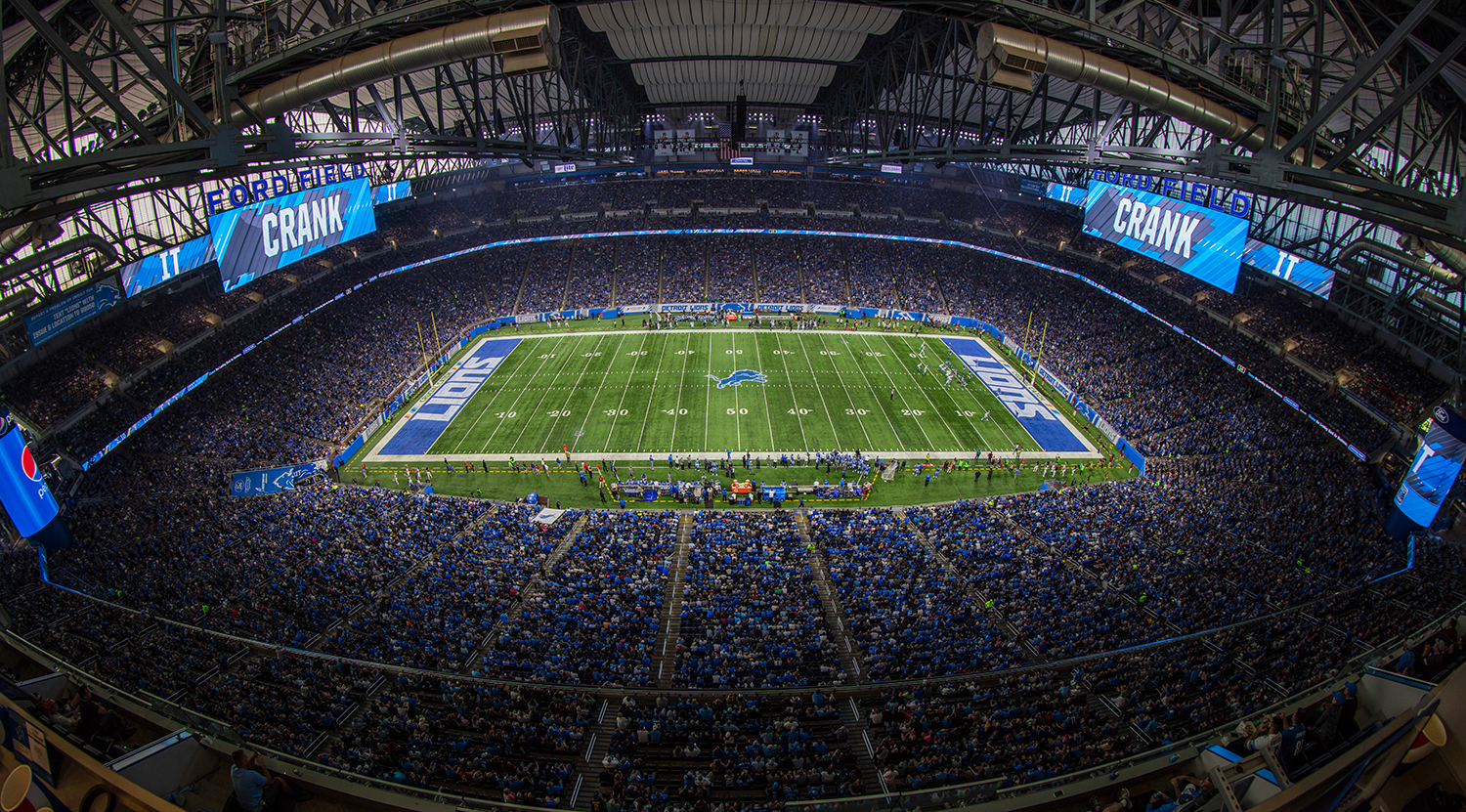Detroit Lions Enhance Game-Day Presentation, Production Efficiency at Ford Field
$100 million project boosts LED display, upgrades control room, adds to broadcast cabling
Story Highlights
The Detroit Lions, one of the NFL’s oldest franchises, shook up the in-game fan experience last summer with all-new video and audio systems at Ford Field, as well as a partial control-room upgrade and the addition of more broadcast cabling. For the Lions’ game-day presentation staff, the goal for this offseason is to see what this gear can really do.
“We’re at the stage of saying, OK, we’ve got a year under our belts. How can we be more efficient and do more-creative things that we weren’t quite sure how they would work the first year?,” says Detroit Lions Director, Event Presentation, Bryan Bender. “But I think, overall, the funds that went in to do the upgrades [last year] were quickly visible in terms of the experience for the fans, which is what we, our management, and ownership wanted. From both an audio and a visual standpoint, the payoff was nearly immediate to fans when they walked in that first game.”
More Than 26,000 Sq. Ft. of LED Includes 21 New Displays
Ford Field opened in 2002; 10 years later, the control room was upgraded to HD. Five years after that, the Lions embarked on a massive $100 million stadium renovation that would touch nearly every facet of the game-day experience.

One-of-a-kind super-column display is 36.5 ft. high x 62.5 ft. around and features 6-mm line spacing.
The most noticeable upgrade is the addition of 21 Daktronics LED displays, including new displays mounted above each end zone that are 250% larger than their predecessors. In total, the stadium now houses more than 26,000 sq. ft. of LED displays, featuring more than 28.1 million LEDs.
The two main end-zone displays measure 39.5 ft. high x 152 ft. wide, with a 13HD pixel pitch. Flanking each end-zone display are two additional 13- x 59-ft. 13HD displays, which can be programmed individually or in conjunction with the main displays to create a 270-ft.-wide canvas.
“It gives our fans a much larger landscape to watch the game or replays,” says Bender. “The palette is so much larger than it was, and it also allows us to add statistical information that we never really had the space to do before. We can break out individual game stats or team comparisons that, with the former setup, we just never really had the space. Plus, it’s so much clearer.”
Four additional displays were mounted to the back of the main displays for fans seated high up in the end zones. That way, if they can’t see the opposite end-zone videoboard, they’ll still have access to all the live game action, replays, statistical information, and more.
Ford Field also installed two one-of-a-kind super-column displays, which measure 36.5 ft. high x 62.5 ft. in circumference and feature 6-mm line spacing. Elsewhere in the stadium, three ribbon boards installed along the exterior fascia of Gate A welcome fans and provide messaging for fans outside the stadium, and four ribbon boards were added to the interior seating fascia.
Lions game days didn’t just look better last season. Working with audio integrator Parsons, the team added new line arrays from Meyer Sound and transitioned from analog to Dante (analog is still used for backup on the main arrays).
Control Room Gets a Boost
Although the Ford Field control room was upgraded to HD in 2012, the Lions opted to revisit the existing gear as part of the renovation. Working with WJHW and Alpha Video, the team added Ross Video XPression and Tessera graphics-control systems to power the new LED displays and upgraded its replay capabilities with three Evertz DreamCatcher servers, one operating in 4K. The team also invested in four IO Industries 4K cameras, which sit in stationary positions at each goal line to capture potential scoring plays.

Overview of Ford Field during a NFL football game against the Carolina Panthers on Sunday Oct. 8, 2017 in Detroit. (Detroit Lions via AP).
“We ended up using [4K replay] in the Green Bay Packers game to overturn a call that the officials had made,” says Bender. “They had called our receiver out of bounds. We quickly got up a replay, our head coach threw the flag, and you could clearly see with the 4K — we blew it up 600% — that the receiver was inbounds. The officials overturned their own call.”
The Lions also added PTZ cameras on each goalpost and three to the super trusses above the field.
Rounding out the seventh-floor control room, the team kept its existing Sony B7000 production switcher in place, upgraded its existing Evertz router, and expanded its KVM system. To accommodate the new equipment and better optimize the space, the Lions flipped the control room layout and added 10 ft. to the space. In addition, the team glassed off a section of the room and added a NewTek TriCaster to create a control room for its pregame show.
For broadcast, the Lions worked with the national networks to boost the cabling, adding network switches in all four corners of the field and nearly a dozen drops throughout the building.
“It’s much more integrated than it was before,” says Brian Haberkorn, game presentation and production manager, Detroit Lions. “The planning [we did for this upgrade] really helped with our efficiency because we already knew how we ran the game and what kind of things we wanted to improve upon. Using that knowledge to build how the room fits helps with our overall game flow [and helps us] be much more efficient in what we’re doing.”
